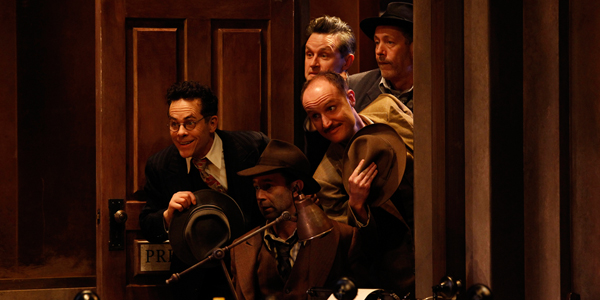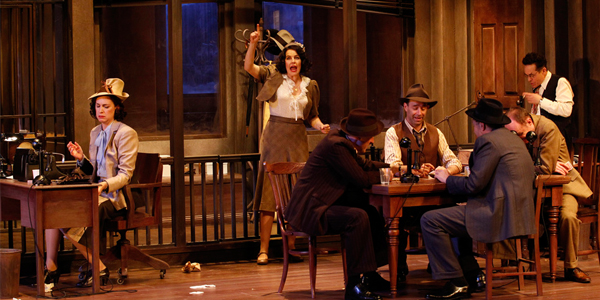A quick look at the classic comic genre.
There was once a New York Giants pitcher called Carl Hubbell who in the twenties perfected a way of releasing a baseball with a flick of the wrist so that it behaved unpredictably in the air. He called it a ‘screwball’ and the term soon slipped into American vernacular for anything unexpected, unorthodox or eccentric. Thus by 1936 a writer for Variety could claim in a review of My Man Godfrey: ‘Carole Lombard has played screwball dames before, but none so screwy as this one.’ The term stuck, not only for the comediennes who played such eccentrics – Lombard, Jean Arthur, Irene Dunne, Ginger Rogers, Claudette Colbert, Barbara Stanwyck and Katherine Hepburn – but for the entire genre of romantic comedy in which they appeared.
As with many artistic genres, screwball comedy is disputed territory; everyone agrees that there was such a thing, yet no one can precisely agree on what it was. However, there are films that most cinephiles would place on their screwball list: It Happened One Night, My Man Godfrey, Bringing Up Baby, Nothing Sacred, The Lady Eve, Easy Living, The Awful Truth, My Favorite Wife, The Palm Beach Story and Theodora Goes Wild. What they all have in common is an eccentric and combative courtship in which the couple are driven in to one another’s arms via a series of madcap, even slapstick, adventures. Those adventures might involve a dizzy bluestocking who falls for a handsome intellectual, or a divorced husband elaborately scheming to win back his wife, or a runaway heiress who connects with a conniving reporter – but whatever the setup, the plot will unwind from a mainspring of wilful eccentricity in one or other of the characters. Like the best dreams, the best screwball comedies make little sense in broad daylight.
The vogue for screwball was brief, a mere dozen years or so from the mid-thirties to the end of the war. Sheer escapism is the usual reason given for its popularity. For an hour-and-a-half, audiences could leave Depression-era America to dwell vicariously among the gowned and dinner-suited leisure crowd who populated the majority of these movies. The screwball world tended toward an art-deco fantasy of swank and glamour; nightclubs, yachts and country clubs; comic butlers and smart-mouthed maids; champagne for supper and breakfast in bed. It is a world short of business and care, allowing the protagonists to fill their days with an elaborate game of catch-and-kiss.
That said – and this might be the real key to screwball’s popularity – the central couple come across as regular Joes and Janes, no more sophisticated than the folk sitting in your average picture palace. This is not the Noël Coward drawing-room world of languid emotions and clipped speech. Energy and fast talking abounds. The settings might be classy, but the screwball couple remain classless.
“His Girl Friday”: still counts as a screwball comedy despite the workplace setting. Plenty of screwball movies revolve around reporters and their drive to get a story, including the classics It Happened One Night and Nothing Sacred. And Walter Burns’s scheming to win back his ex-wife makes him a typical screwball protagonist. Indeed, the ‘comedy of remarriage’ is an entire sub-genre of screwball, the template for The Palm Beach Story, The Awful Truth and My Favorite Wife to name a few. Sometime in the late thirties, screenwriters discovered that they could take more liberties with divorcees than with couples who have just met. It was a good way to subvert, at least a little, the puritan censorship of the Production Code, allowing for heavier sexual innuendo, especially since the ex-wife, the ex-husband and the new fiancé (or fiancée) formed a perfectly irreproachable ménage á trois. And, of course, in any contest of wills, there’s always more fun to be had when the two combatants know each other all too well.
The final scene of a screwball comedy is invariably a capitulation. One or other of the battling lovers can take no more. He – and it is usually the ‘he’ – has been befuddled by the madcap assault on his sensibilities and recognises that he must accede to the inevitable. For good or ill, the screwball pair are meant for each other. Any alternative suitors are dispatched – they were too conventional, those bland Ralph Bellamy and haughty Gail Patrick types – and marriage (or remarriage) is implied in a sealing kiss or a concluding wise-crack.
This article is an excerpt from the His Girl Friday production programme written by Paul Galloway, which can be purchased during your visit to the theatre.
“His Girl Friday”: is now playing at Arts Centre Melbourne, Playhouse until 15 September.
Published on 4 September 2012


